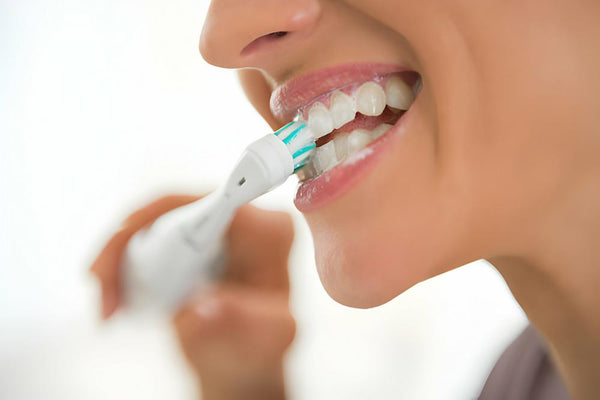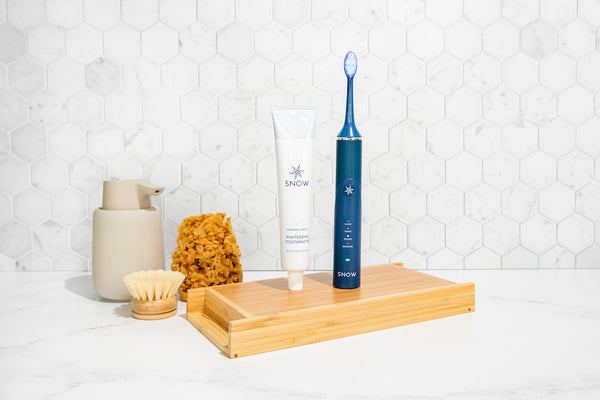Are you one of the unlucky people who regularly thinks, why is my electric toothbrush hurting my teeth? Well, SNOW is here to provide insights. An electric toothbrush can hurt your teeth if used improperly for several reasons like tooth sensitivity, gum damage, and over-brushing..
In this article, we'll delve into the causes behind this issue and offer expert guidance on how to use your electric toothbrush safely.
By the end, you'll have a clear understanding of how to prevent your electric toothbrush from causing harm, ensuring a pain-free brushing experience every time.
What this article covers:- What Is Tooth Sensitivity?
- Can an Electric Toothbrush Damage Your Teeth?
- Are You Damaging Your Gums with Your Electric Toothbrush?
- How to Safely Use an Electric Toothbrush
- What Does Over Brushing Look Like?
- Can You Use an Electric Toothbrush Everyday?
- How Hard Should You Brush?
- Common Causes of Toothaches After Using Electric Toothbrush
- How to Soothe Tooth Pain After Using an Electric Toothbrush
What Is Tooth Sensitivity?
Tooth sensitivity, as SNOW explains, involves discomfort triggered by hot, cold, sweet, or acidic foods and drinks.

According to Mayo Clinic, this sensation often stems from exposed dentin, the layer beneath the enamel. Various factors contribute to this condition, such as gum recession, enamel erosion, and tooth decay.
What Causes Sensitive Teeth?
Understanding these causes is vital for effective at-home teeth whitening. When addressing tooth sensitivity, it's crucial to choose whitening products that minimize discomfort.
SNOW's advanced formulas are designed to provide effective whitening while minimizing sensitivity. By incorporating ingredients that nourish and protect enamel, our products ensure a comfortable whitening experience.
Additionally, maintaining good oral hygiene practices and addressing underlying dental issues can further enhance the success of at-home teeth whitening treatments.
Can an Electric Toothbrush Damage Your Teeth?
Yes, improper use of an electric toothbrush can potentially damage teeth. Vigorous brushing or using a brush head that's too hard can lead to enamel erosion and even tooth fractures.
To prevent damage while still benefiting from the convenience of electric toothbrushes, SNOW recommends using a soft-bristled brush head and applying gentle pressure during brushing.
Additionally, being mindful of brushing technique and avoiding excessive force can help safeguard against potential harm to teeth.
By following proper brushing practices and using suitable equipment, individuals can maintain their oral health and enjoy the advantages of electric toothbrushes without adverse effects.
Are You Damaging Your Gums with Your Electric Toothbrush?
Yes, improper brushing techniques with an electric toothbrush can indeed harm gum tissue and contribute to gum recession. Using excessive pressure or abrasive bristles can lead to irritation and potential damage to the gums.
To avoid causing harm while still effectively cleaning your teeth, SNOW recommends adopting gentle brushing techniques. Instead of applying excessive pressure, let the electric toothbrush's bristles do the work.
Use gentle, circular motions, and ensure that you cover all areas of your teeth and gums thoroughly.
Additionally, it's essential to use a soft-bristled brush head, as softer bristles are less likely to cause irritation or damage to the gums.
By practicing proper brushing techniques and being mindful of the pressure applied, you can effectively clean your teeth without risking damage to your gums.
Remember, maintaining good oral hygiene is crucial for achieving and maintaining a bright, healthy smile.

How to Safely Use an Electric Toothbrush
Using an electric toothbrush safely is essential for maintaining oral health and preventing damage to your teeth and gums. Here are the steps recommended by SNOW to ensure safe usage:
Choose The Right Brush Head
When changing toothbrushes or replacing your electric toothbrush head, it's important to select the right type to continue enjoying a gentle and effective cleaning experience.
Select a soft-bristled brush head for your electric toothbrush. Soft bristles are gentle on the teeth and gums, reducing the risk of irritation or damage. SNOW offers soft-bristled brush heads designed specifically for their Advanced LED Electric Toothbrush.
Hold The Brush At A 45-Degree Angle
Position the electric toothbrush at a 45-degree angle to the gums. This angle allows for effective plaque removal along the gumline while minimizing the risk of abrasive contact.
Use Gentle Circular Motions
Instead of scrubbing back and forth vigorously, employ gentle circular motions when brushing. This technique helps to dislodge plaque and debris without causing unnecessary friction or pressure on the teeth and gums.
Avoid Excessive Pressure
Apply only light pressure when using the electric toothbrush. Pressing too hard can lead to gum recession and enamel wear. Let the electric toothbrush's oscillating motion do the work for you.
By following these steps, you can safely and effectively use your electric toothbrush to maintain optimal oral hygiene and promote a brighter smile.
For your convenience, SNOW offers a range of electric toothbrush options, including the LED Teeth Whitening Electric Toothbrush and the Advanced Whitening Electric Toothbrush. Additionally, replacement brush heads for the Advanced LED Electric Toothbrush are available to ensure continued effectiveness and hygiene.

What Does Over Brushing Look Like?
Over brushing occurs when individuals brush their teeth too vigorously or for an excessive amount of time, leading to various dental issues. To identify over brushing, watch out for signs such as bleeding gums, tooth sensitivity, and visible wear on tooth surfaces.
Here's how SNOW breaks down the signs and manifestations of over brushing:
Gum Recession
One of the visible effects of over brushing is gum recession, where the gum tissue pulls away from the teeth, exposing more of the tooth root.
Enamel Erosion
Over time, aggressive brushing can wear down the protective enamel layer of the teeth, making them more susceptible to decay and sensitivity.
Tooth Sensitivity
Excessive brushing can lead to tooth sensitivity, causing discomfort when consuming hot, cold, or sweet foods and drinks.
Tooth Fractures
In severe cases, over brushing may result in tooth fractures or cracks due to the stress placed on the teeth from aggressive brushing.
Adjusting your brushing technique, using a soft-bristled toothbrush, and practicing proper oral hygiene can help prevent these issues.
Can You Use an Electric Toothbrush Everyday?
Yes, you can use an electric toothbrush every day, and it's an excellent choice for maintaining optimal oral hygiene. However, proper usage is key to avoiding any potential issues.
Here's how SNOW recommends incorporating our whitening electric toothbrush into your daily routine:
Using SNOW's Whitening Electric Toothbrush
Our whitening electric toothbrushes are designed with soft-bristled brush heads to provide gentle yet effective cleaning. The advanced technology ensures thorough plaque removal while being gentle on your enamel.
Recommended Brushing Duration
Brush your teeth for the recommended duration of two minutes, twice a day, using SNOW's whitening electric toothbrush.
This duration allows for comprehensive cleaning and helps maintain a bright, healthy smile.
Incorporating SNOW's whitening electric toothbrush into your daily oral care routine ensures effective plaque removal and helps prevent tooth discoloration, leaving you with a radiant smile every day.
How Hard Should You Brush?
When using SNOW's whitening electric toothbrushes, it's essential to avoid brushing too hard to prevent any potential damage to your enamel and gums.
If you notice your toothbrush turning pink, it might be a sign of bleeding gums due to excessive pressure or the need for a gentler brushing technique.
Here's how we recommend adjusting your brushing technique for optimal results:
Gentle Pressure
Apply gentle pressure while brushing with SNOW's whitening electric toothbrush. The soft-bristled brush heads and oscillating motion of our toothbrushes are designed to efficiently clean your teeth without the need for excessive force.
Let The Toothbrush Do The Work
Allow the electric toothbrush's oscillating motion to do the heavy lifting. By letting the brush glide smoothly over your teeth and gums, you can ensure thorough plaque removal without causing irritation or damage.
Proper Technique
Focus on using proper brushing technique rather than applying excessive pressure. Hold the toothbrush at a 45-degree angle to your gums and move it gently in small circular motions to reach all surfaces of your teeth effectively.
By following these guidelines and using SNOW's whitening electric toothbrushes correctly, you can achieve a brighter, healthier smile without risking damage to your enamel or gums.
Common Causes of Toothaches After Using Electric Toothbrush
Toothaches after using an electric toothbrush can stem from various factors, impacting your dental health and comfort. Here's what you need to know:
- Incompatible brush heads: Using brush heads that are not compatible with your electric toothbrush can lead to discomfort and toothache. Ensure you're using the correct brush heads recommended for your device to avoid irritation.
- Improper cleaning: Failure to clean your electric toothbrush properly can result in bacterial buildup on the bristles, which may cause toothaches when brushing. Regularly clean and sanitize your brush heads to maintain oral hygiene.
- Underlying dental issues: Toothaches could be indicative of underlying dental problems such as cavities, gum disease, or tooth sensitivity. Consult with a dental professional to address any existing dental issues contributing to discomfort.
By understanding these common causes and taking proactive measures to adjust your brushing technique and address potential issues, you can mitigate toothaches after using an electric toothbrush and maintain optimal oral health.
How to Soothe Tooth Pain After Using an Electric Toothbrush
After experiencing tooth pain following the use of our electric toothbrush, it's essential to take immediate steps to alleviate discomfort. Here's what you can do:
- Rinse with lukewarm saltwater: Gently swish a solution of lukewarm water and salt in your mouth. Saltwater helps reduce inflammation and kill bacteria, providing relief.
- Apply a cold compress: Place a cold compress or ice pack wrapped in a cloth on the outside of your cheek over the affected area. Cold therapy can numb the area and reduce swelling and pain.
- Avoid extreme temperatures: Steer clear of extremely hot or cold foods and beverages, as they can exacerbate tooth sensitivity and discomfort.
By following these steps, you can effectively soothe tooth pain after using an electric toothbrush and ensure your oral health remains optimal.
Conclusion
To wrap up, the article emphasizes the importance of proper electric toothbrush usage for optimal dental health. While these toothbrushes efficiently remove plaque, incorrect techniques can result in discomfort and potential dental problems.
It's crucial to employ correct brushing methods, such as gentle yet thorough brushing and avoiding excessive pressure. Additionally, selecting the appropriate brush head tailored to individual needs plays a vital role in achieving effective oral care. Addressing underlying dental issues promptly ensures comprehensive dental health.
Remember, maintaining a healthy smile encompasses more than just brushing—it's about using the right tools and techniques to safeguard your teeth. For superior teeth whitening results, explore SNOW's innovative toothbrushes at SNOW.
If you want to learn more, why not check out these related posts:
- Toothbrush Hurt My Gums
- Why Should You Change Your Toothbrush Every 3 Months
- Best Electric Toothbrush for Small Mouths
- When to Change Your Toothbrush After Strep
- Best Toothbrush for 1 Year Old
- Best Toothbrush for 4 Year Old
- Best Electric Toothbrush for Elderly
- Toothbrushes for Different Ages
- Bamboo Toothbrush Benefits
- Tongue Scraper vs. Toothbrush
- Soft vs. Extra Soft Toothbrush
- Electric Toothbrush Round Head vs Oblong
- Bamboo Toothbrush Mold
- When to Change Toothbrush After Being Sick
- How to Clean Electric Toothbrush

























